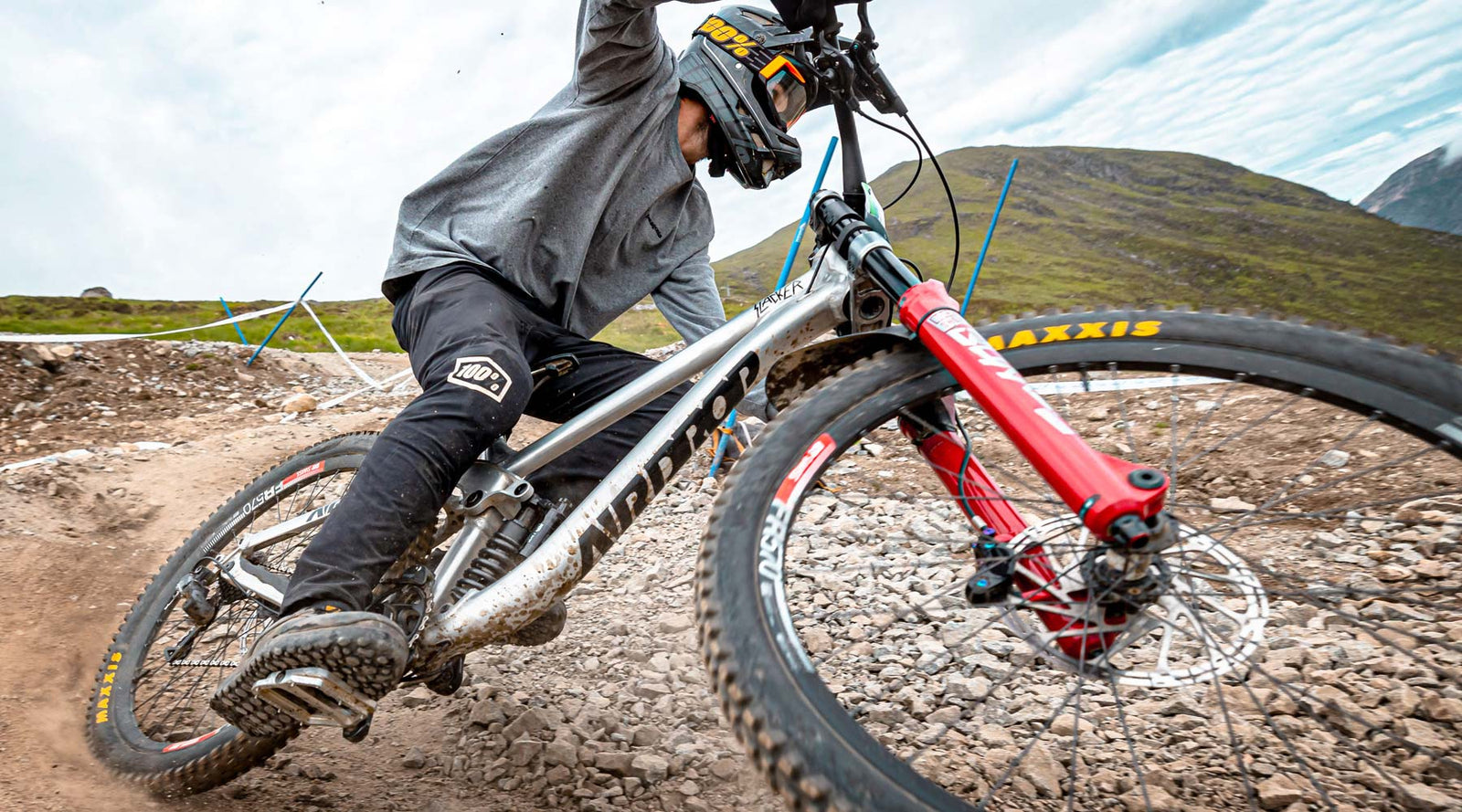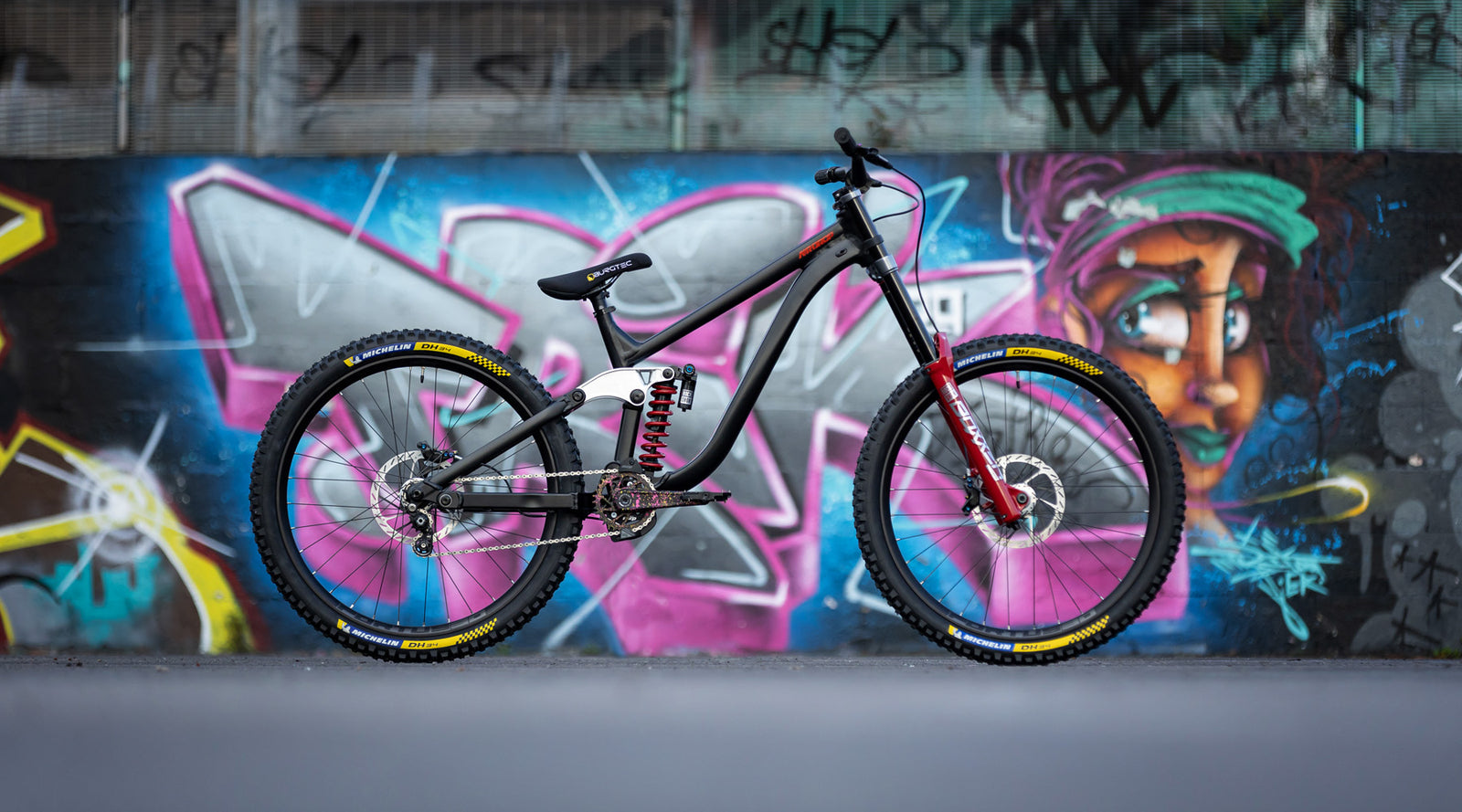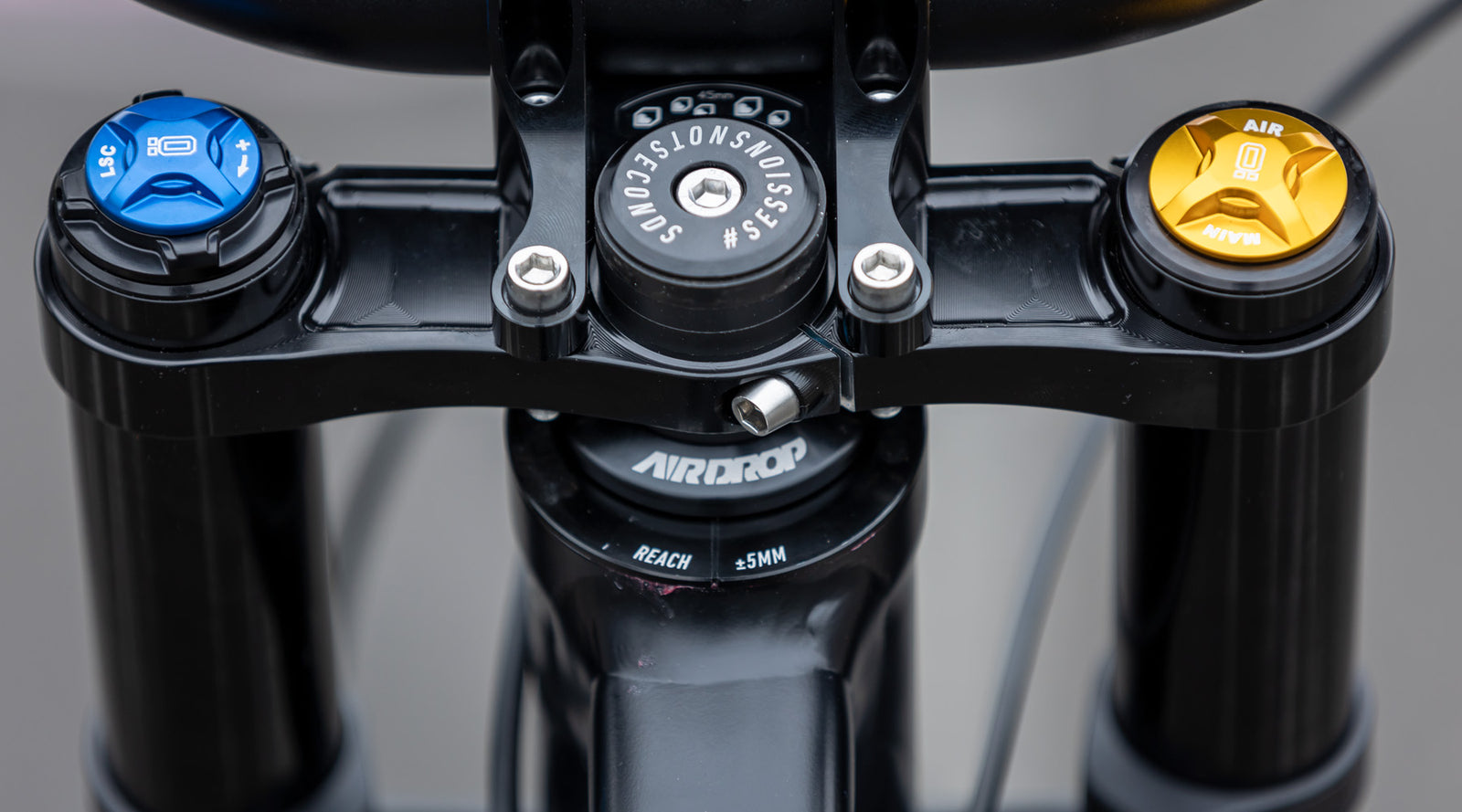
12: It's Not A Race Bike
July 01, 2021
With most things being cancelled the past 18 months, getting out on the Slacker has been tricky, but the SDA race at Glencoe was the perfect opportunity to test the prototype on the high-speed straights and loose turns of a proper DH track.
Now, we don’t intend the Slacker to be an out and out race bike, that’s why it revolves around 27.5" wheels; we want to keep that fun, playfulness that the smaller wheels provide. The majority of race bikes nowadays seem to have 29" wheels and some sort of high pivot with an idler in there. We get why, and it does make sense for going as fast you possibly can on rough, blown out world cup tracks. However, the kind of stuff we like to ride on a DH bike doesn’t warrant this. We don’t want a bike that gets longer in the turns, we want a bike that stays compact and agile, so you can rip round turns, boost jumps and just have fun in the woods, which is what bike riding is all about to us.

The SDA Series
My first ever DH race was an SDA at Ae Forest back in 2007. The Scottish series is an ideal starting point if you want to give DH racing a go. It’s a chilled, laid back atmosphere. You get two race runs, so you don’t have all that pressure on putting down one good run. If you mess your first one up, you get the opportunity to go up and give it another go, plus you get more bike riding in and that’s why we’re there in the first place! Plus you get a full day of practice on the Saturday. A race weekend for me isn’t so much about the racing, it’s about hanging out with mates and doing laps on DH bikes and just having a good time riding bikes.
An SDA weekend for me starts out on the Friday morning with track setup, we get there nice and early to ensure we have enough time to tape the track and get everything set up before riders begin to arrive for registration on the Friday evening. If you haven’t been to Glencoe before, it’s definitely one of the most scenic places in the UK to ride! For the first SDA since September 2019, we decided to use the red run, to ease riders into the season after a year off racing for most. Even though it is classed as a red run, once things get up to speed it becomes a very tricky trail, a few high speed, rocky straights interlinked with some tricky, loose turns keep you on your toes. As far as tracks go for taping the red run is one of the more straight forward ones. However, with there being no trees on the hill it requires a lot of ski poles to keep the tape in check. There’s only really one way down the hill so you can’t go too crazy taping in fresh sections, you can try adding in a few sneaky lines to keep things interesting, but for the most part it just follows the main red run down the hill.

Once taping is done its time for a quick lap for ourselves, partly to make sure what we’ve just taped in works and to also to get a GoPro run and get a track preview online to get riders fired up for a weekend of racing. After a quick lap it’s down to the car park to get our own pit set up, fire up the BBQ and spend the evening having a catch up.
Saturday is a full day of practice, in my opinion it’s the best day of the weekend. You just get to ride your bike the whole day, no waiting around for a specific time to do a race run, you can squeeze in as many laps as you like. Some people like to push up and session or just sit and watch a section for a bit, I don’t worry too much about where I’m going, if it feels good on the bike and I don’t lose any flow it’ll do for me, I’m more focussed on having a good time and maximising my time on the bike.
Racing is on Sunday, you get a couple of hours practice in the morning just to make sure you know where you’re going and check nothing has changed drastically overnight, I’ll try and get in 2 runs on the Sunday morning, purely to get more time on the bike. Then that’s it practice is over, time to wish you spent more time looking at lines and figuring out how to go fast, time to get serious! Even though I’m not there to race, once it comes round to race runs you can’t help but get that nervous feeling in your stomach and wish that you were still just riding in practice. No matter how many times I tell myself my race run is just another practice run it never works out that way, I always ride a little bit tighter or overthink basic things, I can just never replicate the feeling I have when I’m riding in practice. First race run I always like to put down a solid safety lap, just riding at a pace I know I can maintain and not take too many risks, then I can go for it second run knowing I’ve got a solid time to fall back on.

First Race on The Slacker
Anyway, back to the Slacker. For me, for my riding style and the kind of riding I enjoy the Slacker is the ideal bike, it rips round corners with ease and it’s playful and nimble on the faster sections where quick changes of direction are required. Plus you can hit anything on it and the suspension behaves in a controlled, predictable manner. Setup wise I didn’t make any drastic changes, I did drop the front end slightly in an attempt to get more grip on to the front tyre in the loose conditions, but apart from that everything was as it was when I arrived.
The Slacker never missed a beat, 12 runs in two days and all I had to do at the end of the weekend was wipe the dust off. Speaking of dust, this was the most challenging part of the race, there was a very fine line between going fast and being on the floor, the track surface at Glencoe is made up of loose rock and gravel, combined with the lack of rain the west coast of Scotland has seen recently made for some pretty tough conditions to race on! As soon as you began to push, your tyres started to move around in all directions, not really giving you a solid base to turn or brake on, you couldn’t really tell what your wheels were doing under you. You just had to commit to the turns and keep your braking in a straight line and things stayed semi in control. With the track being so loose having the agility of the Slacker definitely played out in my favour, if the bike got off line or stepped out unexpectedly in some gravel I could, for the most part, get it back in line and carry on. With there being so many tight, awkward corners on track I could just lean the bike in, hope the tyres would grip and let it roll through, maybe the low BB and the smaller wheels of the Slacker helped me with this.
With the track being so loose having the agility of the Slacker definitely played out in my favour.
Race Runs
Having gotten on well with the Slacker all weekend it was time for race runs, my first run I put down a 3.21 which was good enough for 3rd place after first runs. After putting down a solid, safe first run it was time to push on a bit in my second run. Which unfortunately didn’t work out for me, as soon as you began to push on this track things got loose very quickly. I just entered a corner a little bit too fast, got a front wheel drift on and just slowly placed the front wheel over the top of the corner. Nothing major but a race run spoiler, I eventually got back on track and came down with a 3.23 in my second run. A few people went faster in their second runs pushing me down to an overall 4th place. Still, I’m happy with that and I got a full weekend of seeing my mates, riding DH and testing the Slacker out of it, so the decent result is just a bonus!

This was the first race I’ve been to since we began the Slacker Project back in 2019, so it was the ideal opportunity to see what other bikes are going around the pits. From a quick first look, it’s clear the high pivot Commencal Supreme is a favourite of the privateer racers in the UK, in many configurations too, full 29er, mullet and even a few 27.5 going about. It seems like the success Commencal is having on the world cup scene is selling bikes for them. In the UK I don’t fully see the need for a big, long 29” high pivot DH bike; apart from the exception - Fort William - the majority of UK DH tracks are tight, twisty and awkward to get down, having a bike that is nimble and easy to move around makes more sense to me than wrestling a long 29er down, giving yourself an upper body workout in the process.
There were also a fair few Enduro bikes too, which under the right rider can be very capable, in fact fastest time of the day this weekend was set on an Enduro race bike (long travel, high pivot, idler). I can see some tracks in the UK where an Enduro bike will be the faster option, however if I’m getting a lift to the top, I’d choose a DH bike any day. Your bike also takes a beating over a race weekend, a DH bike is much more forgiving in terms of maintenance, chances are you could do a full race weekend and not have to touch your DH bike, however if you’re riding your trail bike you may have some fixing up to do after the race. I know loads of people say they can only afford one bike, but if you have to replace it twice as often, you might have been better off having a trail bike and a DH bike in the first place. Plus if you’re getting a lift to the top, why not ride a DH bike, you can hit things harder, go faster, jump further and just have more fun on the way back down and you’ll be able to ride for longer because your body isn’t getting as beaten up.
You can hit things harder, go faster, jump further and just have more fun on the way back down
Having not really spent too much time on the Slacker over the winter and riding my Edit 5-6 times a week I was contemplating just racing the bike I was most comfortable on, which of course is my Edit, I’m so glad I didn’t! I hit some holes this weekend that would’ve had me folding in half if I was on my Edit. I don’t think I would’ve gone any faster on my Edit, in fact with how blown out the track got towards the end of the weekend I reckon I would’ve gone slower and probably broken some parts in the process. Getting used to the Slacker after coming from my Edit was fairly straightforward, it’s always a bit alien riding a DH bike for the first time in a while, getting used to the softer suspension, grippy tyres and less feedback, you forget how hard you can hit things or what you can actually just ride over on a DH bike, if you’ve never tried one you really should, it’s quite amazing what they’re capable of.

Considering the bike I raced this weekend is really just a first prototype, it handled everything well. No gripes with any aspect of it's handling or performance. But we have made a series of major updates which we'll be releasing in the next chapter. If you're following this for the tech, it'll be a good one. We've rolled all those updates into a new prototype and we're hoping that will be the last big step towards a production-ready Slacker...
All images courtesy of Phill Rodham @digital_downhill
Scottish Downhill Association
The Glencoe race was organised by the SDA, a non-profit organisation which Andy is a part of. For more info on this year's SDA series or to get involved, hit the SDA website: www.sda-races.com
Previous Chapter:Ride Testing |
Next Chapter Coming Soon:Design Updates |
Ed Brazier
Ed is the owner of Airdrop Bikes. A former web and graphic designer, he sacked off his job one day and decided to start up a bike brand.
1 Response
Leave a comment
Comments will be approved before showing up.
Also in The Slacker Project

19: The End
January 24, 2023
We made it. And although it's been a massive team effort, James has been the main man. So it's only fitting that he should have the last word...
Read More

18: The Devil's In The Details
January 13, 2023
One last chapter to nerd out on all the little details of the Slacker frame before we launch in a couple of weeks.
Read More

17: The Range
December 25, 2022
Find out all the juicy details of Slacker build kits, spec and pricing.
Email Newsletter
Our monthly email newsletter gets you access to all the good stuff before everyone else.
Get The Inside Line
We're always working on stuff behind the scenes and we'd like to share those stories with you. One email a month, and we make it worth a read.
Sign up to get the inside line.

Fabio
November 23, 2021
When will this beauty become available in the shop?